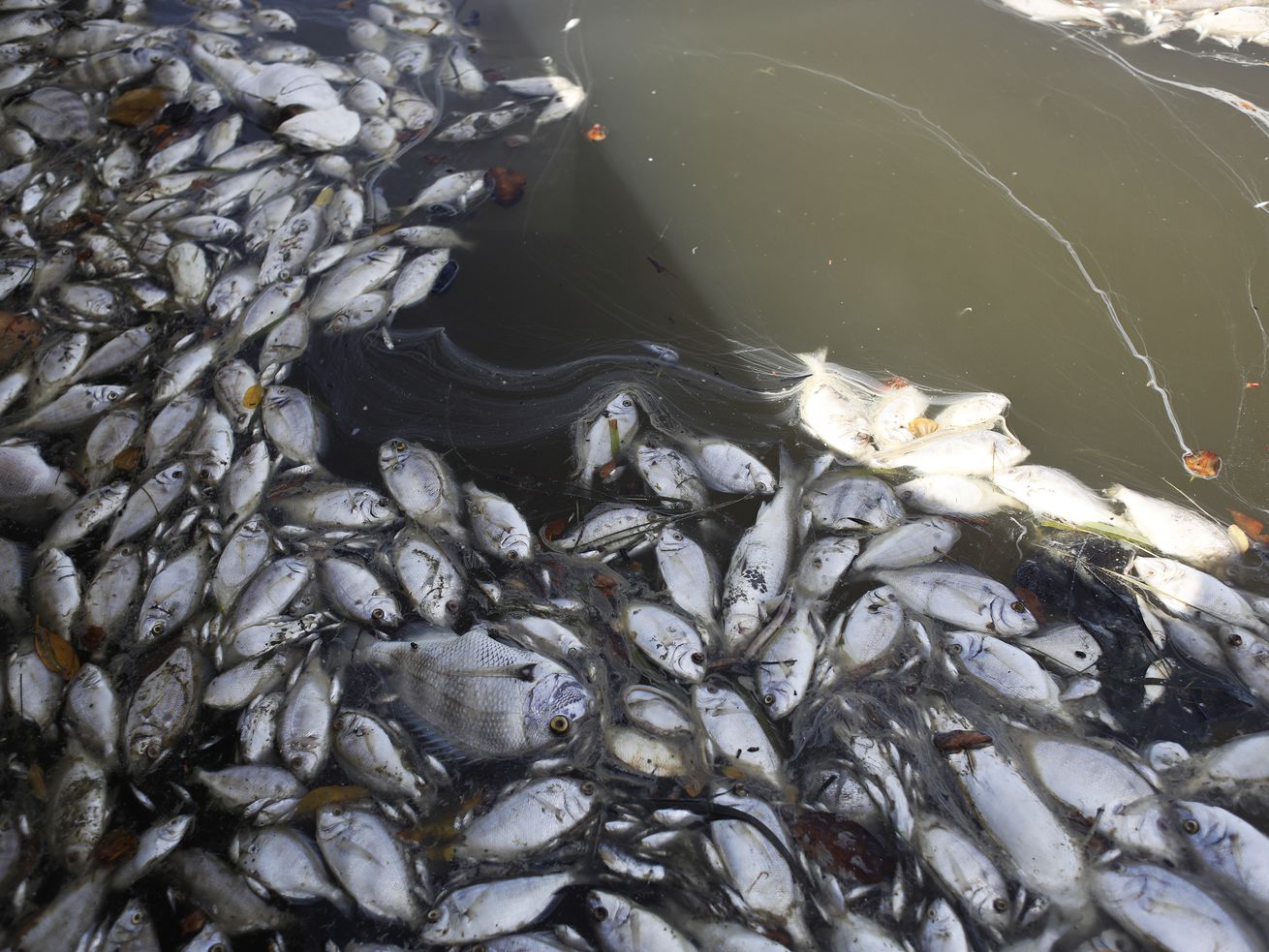A toxic “red tide” is killing fish, displacing sharks, and going viral on TikTok. Is it getting worse?
This story is part of Down to Earth, a Vox reporting initiative on the science, politics, and economics of the biodiversity crisis.
The scenes from western Florida are hard to stomach: fish carcasses dotting beaches for miles, a backhoe lifting a 400-pound goliath grouper out of the water, hundreds of sharks swimming through neighborhoods, and hordes of maggots wriggling along the shore.
In the past three weeks, more than 1,700 tons of dead fish and other marine organisms and debris have washed ashore along beaches near Tampa Bay. They were killed by an overgrowth of toxic algae, known as red tide, that came inland earlier this summer.
While algal blooms are a natural phenomenon in southwest Florida — and across much of the world — they’re typically not this severe. The algae have not only killed untold thousands of fish and more than a dozen manatees but also sickened some beachgoers, who can experience respiratory issues when the toxins become airborne.
Now scientists are racing to determine what makes a year particularly bad for red tides — and whether they’re becoming more common. The last major red tide was just three years ago, when then-Gov. Rick Scott declared a state of emergency, as Vox’s Brian Resnick previously reported. The state’s current governor, Ron DeSantis, has rebuffed calls from environmental groups to declare a state of emergency for this year’s red tide.
Red tides in Florida result from a complicated set of variables, from ocean currents to weather patterns, researchers have learned. And while these events are not necessarily becoming more common, as you might expect, climate change is making them much harder to forecast — and Florida’s booming population is making them far more visible.
/cdn.vox-cdn.com/uploads/chorus_asset/file/22760508/GettyImages_1234097981.jpg) Octavio Jones/Getty Images
Octavio Jones/Getty ImagesHow a microscopic creature can kill so many fish
Dead fish, ruined vacations, and other consequences of Florida’s red tide can be tied to just one tiny species: Karenia brevis. It’s a type of marine algae, or phytoplankton, native to the Gulf of Mexico.
While they don’t always make national news, blooms of K. brevis typically occur every year. Starting in late summer, a deep-water current in the Gulf tends to move east toward Florida, causing an upwelling of nutrients like phosphorous and nitrogen that feed the algae and push them toward the coast, where they find other sources of nutrients.
/cdn.vox-cdn.com/uploads/chorus_asset/file/22760500/5807660623_328c28305c_o.png) Florida Fish and Wildlife Conservation Commission
Florida Fish and Wildlife Conservation CommissionNormally, the blooms — which can be a rusty red in hue — last for only a few months and impact a relatively small area. But on occasion, they grow uncontrollably and start wreaking havoc on marine ecosystems. That’s because K. brevis produces brevetoxin, an odorless neurotoxin that can be fatal to fish and other marine animals.
While scientists aren’t sure why the algae make toxins, one interesting theory is that it’s to kill fish by design. Rotting fish essentially fertilize the water, which in turn creates more algae. “The toxins have to have a purpose, and it might be killing fish to get the nutrients,” said Cynthia Heil, director of the Red Tide Institute at Florida’s Mote Marine Laboratory & Aquarium. “This little one-cell plant may actually be farming.”
In large numbers, these microscopic organisms also pose a threat to human health. Waves can break open the algae cells and release the toxin into the air. Inhaling it can cause respiratory issues and feel like “you’re starting to get a cold,” Heil said. Studies have linked severe red tides with a rise in hospital visits, especially among older adults.
/cdn.vox-cdn.com/uploads/chorus_asset/file/22759279/statewide_combo0730.png) Florida Fish and Wildlife Commission
Florida Fish and Wildlife Commission/cdn.vox-cdn.com/uploads/chorus_asset/file/22760455/51328378513_dd53a93289_k.jpg) Florida Fish and Wildlife Conservation Commission
Florida Fish and Wildlife Conservation CommissionWhy this year’s red tide has been so bad
Although K. brevis is well-studied, it’s still not clear why it explodes in some years. Each major red tide event seems to have its own unique equation, experts say.
This year, southerly winds helped keep the bloom close to shore, where it could feed off pollution spilling into the water. Meanwhile, months of drought ahead of Hurricane Elsa likely made estuaries around Tampa Bay saltier, allowing the marine algae to move farther inshore. Plus, more than 200 million gallons of wastewater from an abandoned phosphate mine known as Piney Point was pumped into Tampa Bay last spring.
“There was this huge pulse of nutrients into the bay,” Heil said. While it didn’t outright cause the bloom, it may have made it worse, she added. “It’s been a very odd year.”
Ultimately, the red tide killed more than 1,700 tons of sea life in Pinellas County, which hugs Tampa Bay, and that number could continue to grow. The bloom is also implicated in the death of 17 manatees in June and July, according to the Florida Fish and Wildlife Conservation Commission (FWC).
Floridians also reported seeing hundreds of live sharks evading the red tide by swimming into human-made canals and waterways in the Tampa region. “You literally could have walked across the canal on the backs of sharks — that’s how many there were,” Janelle Branower, a resident of Longboat Key, told Allyson Henning, a reporter with a local NBC news channel.
The toxic bloom is now beginning to dissipate, and hundreds of government workers have been working to clean up mountains of dead fish. (In Pinellas County, dead fish can be burned along with other trash to produce electricity, a county official told Vox.) But it’s only a matter of time before the next severe bloom strikes, experts say.
/cdn.vox-cdn.com/uploads/chorus_asset/file/22760461/51345153117_09152555f5_k.jpg) Florida Fish and Wildlife Conservation Commission
Florida Fish and Wildlife Conservation CommissionRed tides aren’t becoming more common in Florida
A cursory glance at state data showing the number of red tides over time suggests that these events are becoming more common in Florida. That’s in line with a handful of media reports that indicate climate change is fueling harmful algal blooms.
But that frightening conclusion isn’t quite right, experts say. “I don’t think we’re in a position to say with any certainty that the frequency of the events has been increasing,” said Thomas Frazer, a professor in the college of marine science at the University of South Florida. A recently published review of the evidence came to the same conclusion for Florida’s red tides: “no significant trend over time is evident,” the review reads.
So why do harmful blooms appear to be increasing?
For one, scientists have ramped up sampling efforts over time, Frazer said. The more you sample, the more likely you’ll be able to detect a toxic algae bloom. Florida has also seen a massive influx of residents in the past decade, so there are simply more people affected by red tides. “Each new bloom is undoubtedly the worst for many residents, regardless of trends,” Heil said. Plus, social media platforms like TikTok have brought a new level of attention to algal blooms. (Several top recent red tide videos on TikTok have tens of thousands of views.)
/cdn.vox-cdn.com/uploads/chorus_asset/file/22760468/GettyImages_1234099397.jpg) Octavio Jones/Getty Images
Octavio Jones/Getty Images/cdn.vox-cdn.com/uploads/chorus_asset/file/22760443/GettyImages_1234098725.jpg) Octavio Jones/Getty Images
Octavio Jones/Getty Images“You should not underestimate that there is a very strong human behavior factor involved,” said Gustaaf Hallegraeff, a professor emeritus at the University of Tasmania who’s been studying harmful algal blooms for decades. “The more people there are on the coast, the more blooms they see.”
Hallegraeff points out that records of red tides date back hundreds of years, and fish kills have been documented since at least the mid-1800s. The worst bloom in history — which spread from Sarasota down to the Florida Keys — was likely in 1947 and killed an estimated half a billion fish.
Climate change is making blooms unpredictable, but forecasts are improving
There’s some reassuring news in this history, Hallegraeff says. For one thing, “it’s not a new phenomenon. It’s always been there.” Other parts of the world are dealing with new outbreaks of harmful invasive species, he said, and this isn’t one of those.
Still, red tides could get more severe or longer-lasting, he said, as coastal houses and factories contribute to algae-fueling pollution. (There’s not great data showing whether the severity or duration of blooms is increasing, and it’s still a matter of debate among scientists.)
“Red tides are naturally occurring, but we have the capacity to make them worse,” Frazer said. “Increased nutrient delivery is a global problem and arguably the largest problem affecting water quality around the globe.” Nutrient-rich runoff is also fueling a massive “dead zone” farther east in the Gulf of Mexico, which is also caused by algal growth.
Climate change is certain to have some effect, experts say. Rising temperatures can alter ocean currents, raise sea levels, heat the water, and increase the frequency and intensity of droughts and hurricanes. Meanwhile, carbon dioxide affects the acidity of water and the growth rate of photosynthetic organisms like algae. All these variables will likely impact red tide. “Climate change makes algal blooms less predictable,” Hallegraeff said. “That’s the real impact.”
It’s a good thing, then, that researchers are getting better at forecasting blooms. The Florida Fish and Wildlife Conservation Commission can process hundreds of water samples a week, with the help of a sampling robot that measures levels of K. brevis and whether they’re growing.
“The more we know about the ecology of the organism, the better we are able to model it under different conditions,” said Kate Hubbard, director of the Center for Red Tide Research at FWC. Researchers are also experimenting with tools that can fight the blooms directly, from clay (which is used to fight blooms in China) to brewer’s spent grain (a common byproduct in making beer).
In the meantime, the National Centers for Coastal Ocean Science runs a respiratory forecast for red tide in beaches in western Florida, which is updated every three hours. “It’s really helpful to have these new forecasting tools and models that try to predict where it’s good to go, given that there’s an ongoing bloom,” Hubbard said. “It can change over the course of the day, or over the course of a few days — it’s a dynamic organism.”
Author: Benji Jones
Read More



